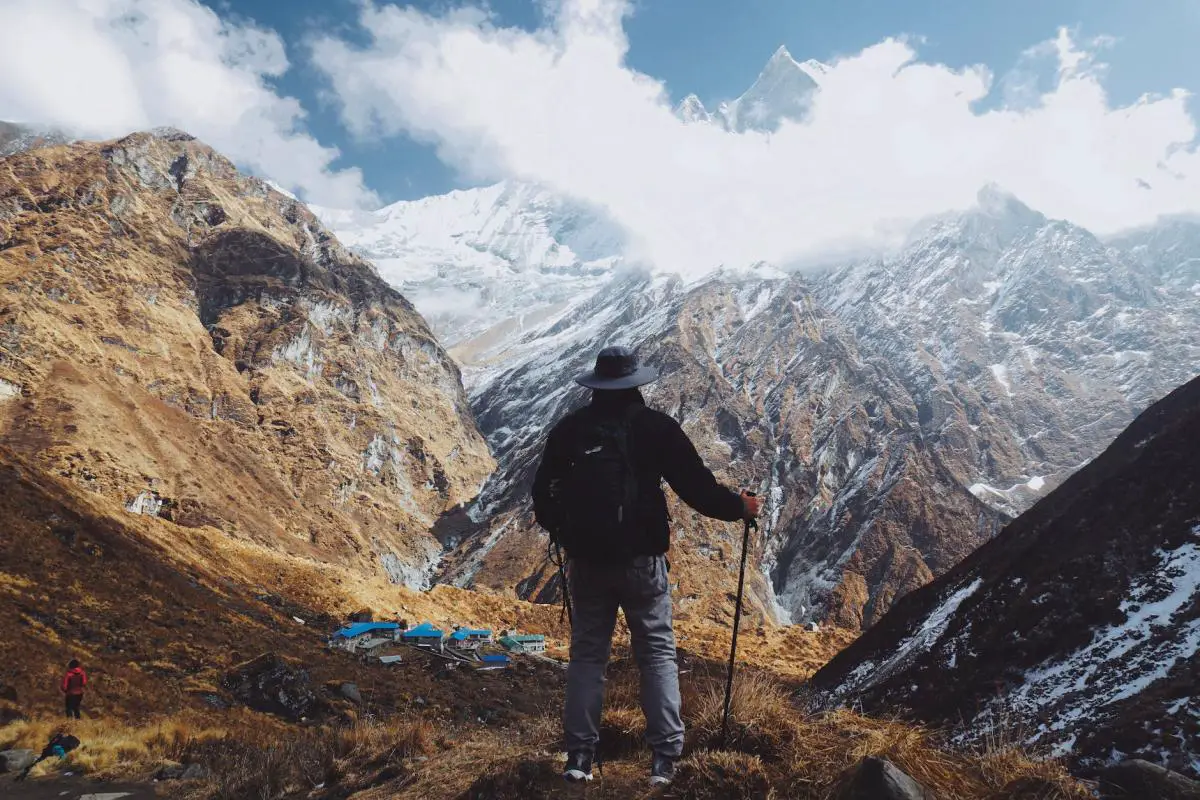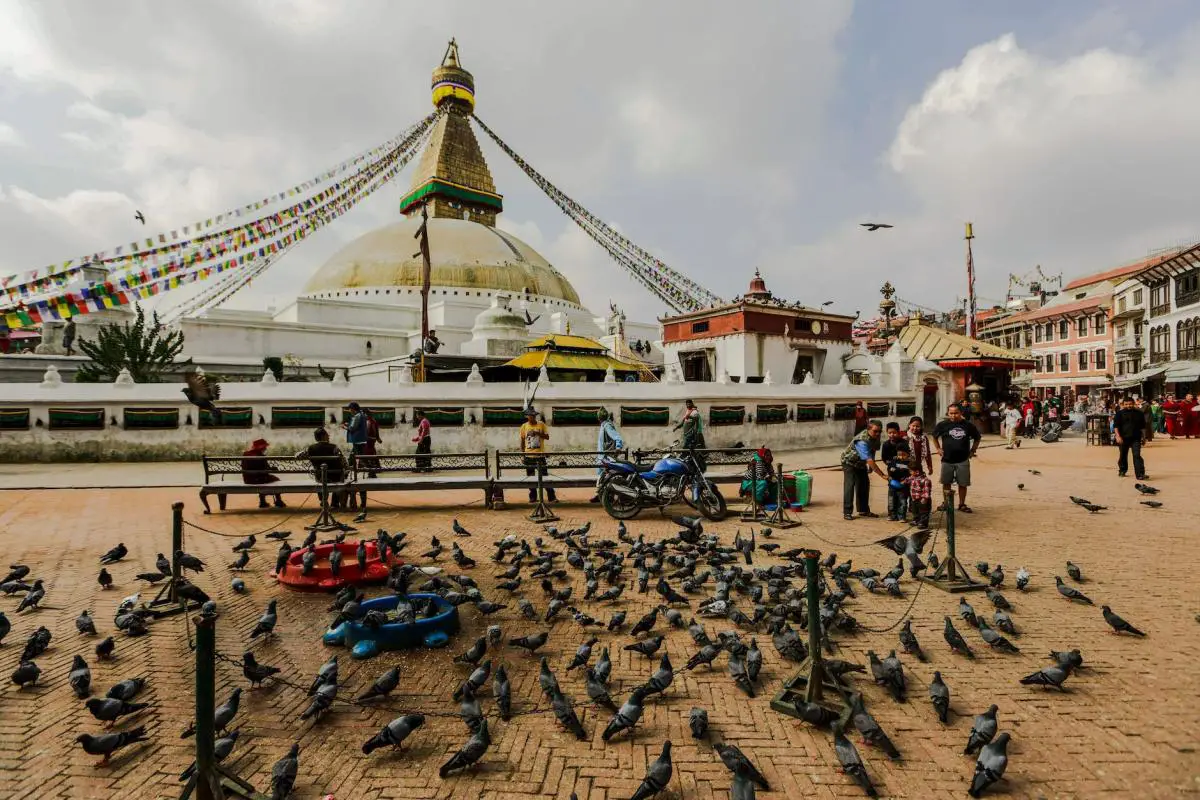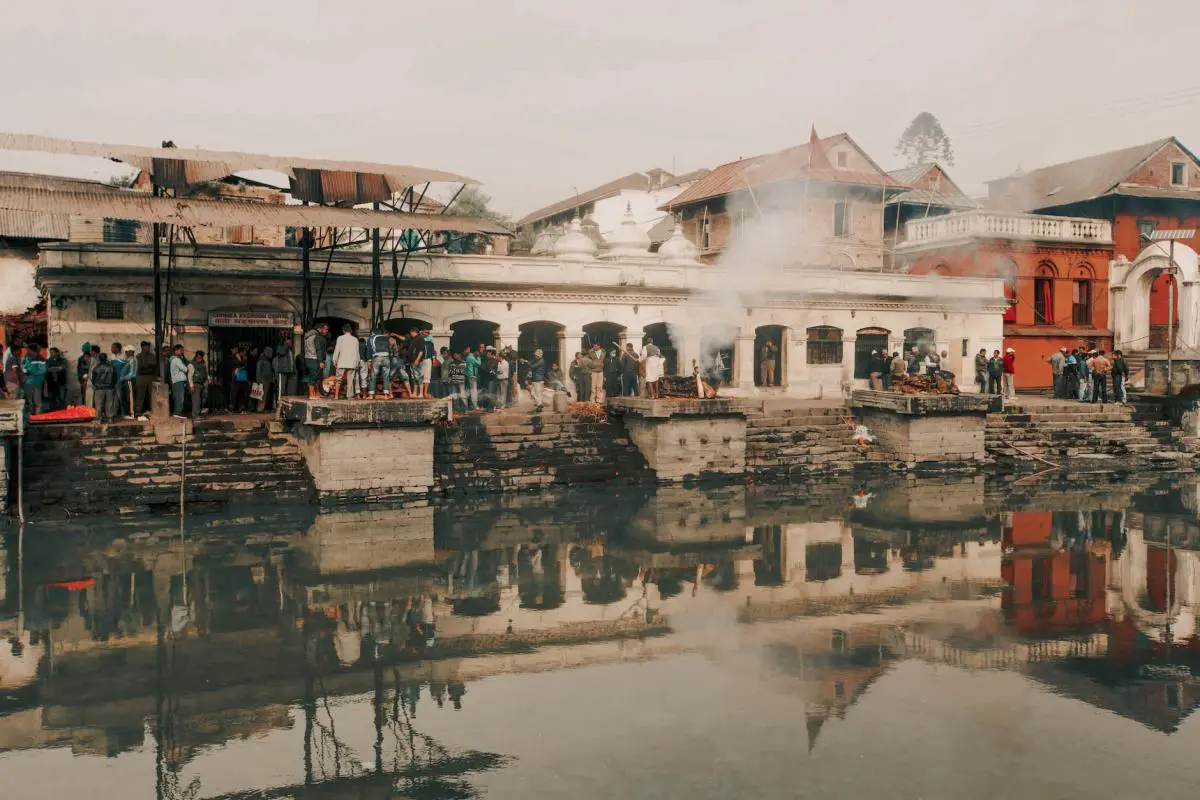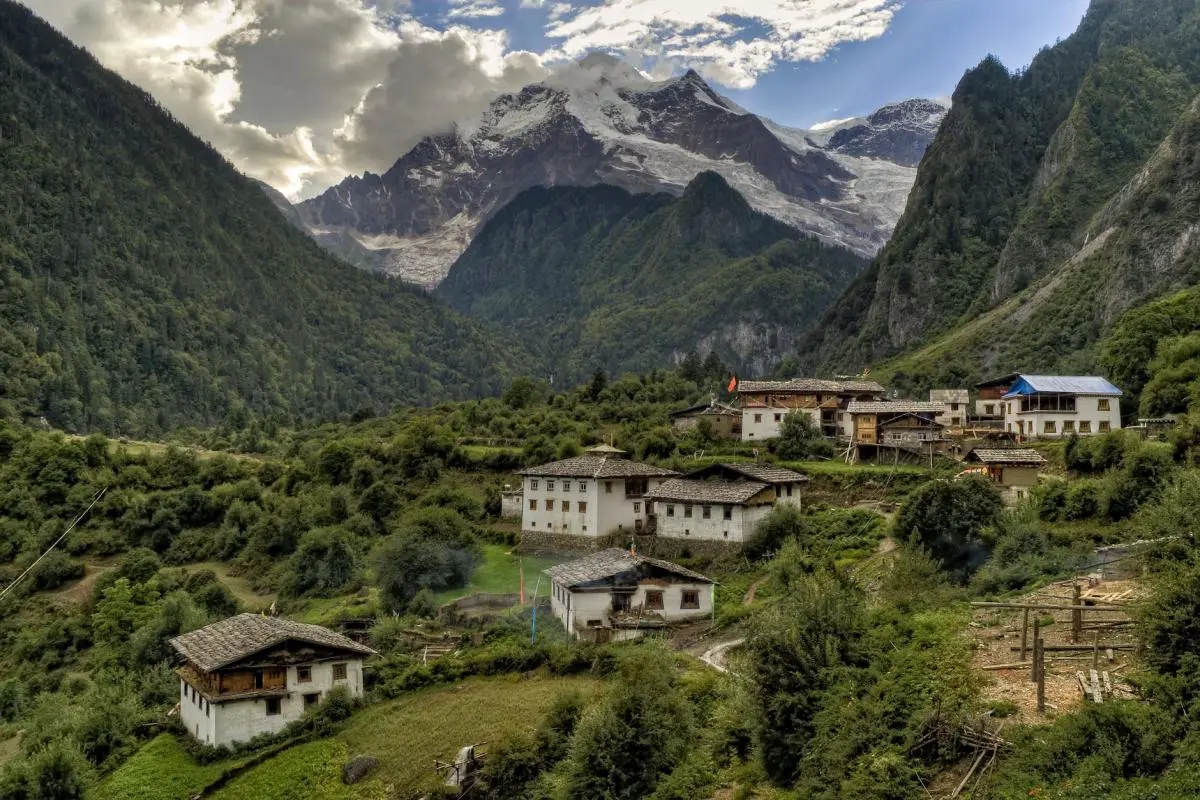Nepal is a pretty interesting country. Mostly because of its high mountains: Nepal has eight of the world’s highest 14 mountains! And of course, it has the highest – Mount Everest. With mountains comes amazing trekking routes, such as the Langtang Valley Trek, Everest Base Camp, and the Annapurnas. But what if you don’t have the time or the desire to trek? What else does Nepal have to offer?

Here are details of the ultimate one week itinerary for Nepal.
Arriving in Kathmandu
Flying into the Tribhuvan International Airport, named after a past King, is an amazing experience. It’s a mountain flight in itself! As you fly over the Himalayas the mountains are displayed around you. Depending on where you are flying from, check beforehand which side of the plane gets the best views.

From the air the city is not as impressive as many other cities and the airport itself is pretty small. It’s part of its charm that you disembark the plane onto a bus which takes you around 50m to the arrivals building.
If you have already obtained your visa then all is good, go straight to the immigration desk. If you don’t have a visa I suggest you fill in the form on line before landing and have cash dollars in your hand. On the immigration website it does say you can fill in the visa application at the airport, but the machine for that process is often out of order, or extremely busy. Do it ahead of time!
Then its down to collect your luggage. It might be quite a wait. Depending on how many flights arrived at the same time as yours, you have already spent more than an hour just getting through this small airport. Luggage collected, head down the crazily steep corridor and out into the world.
Hint: if possible, bring only hand carry with you.
Back to the Future
The Nepali calendar, Bikram Sambat, is approximately 56 years ahead of the rest of us. Approximate because their new year happens in mid-April. Welcome to the future!
Hint: get a prepaid taxi by paying inside the airport, just near the exit door. So much easier than haggling with taxi drivers outside.
Accommodation
There is a massive range of accommodation in Kathmandu. Most tourists stay in the area called Thamel which has great nightlife, and many shops. But accommodation wise, it really depends on your budget. There are plenty of inexpensive hotels in this area, but if you want something a little better there is Aloft and Fairfield, both part of the Marriott group. For something more in keeping with the old style of the city, there is the Kantipur Temple Hotel, or, about a 15 minute easy walk away, the Shankar Hotel.
Your One Week Nepal Itinerary
Assuming your flight has arrived by the early afternoon, let’s start the itinerary off quite gently.
Arrival Day: Swayambhunath Stupa
Swayambhunath is about a 30 minute walk from Thamel or a 10 minute taxi ride. This is often referred to as the Monkey Temple, for reasons that will become obvious. Do not carry any food with you!
Mythology says – and there is a lot of mythology associated with the Kathmandu Valley – that the valley was once an enormous lake (that part seems pretty factual according to science) with a huge lotus flower in it. Seeing that this lake could be a more beautiful valley, Manjushree, a Buddhist deity, took a sword and cut a channel to drain the lake. You can still see this channel at Chobar Gorge where the water runs out of the city. The lotus itself was transformed into what is today the hill that Swayambhunath stupa stands on.

From here you get good views of the city, and if you are lucky, you can see the sun set over the city.
Day 2: Pashupatinath / Kathmandu Durbar Square / Boudhanath Stupa
Pashupatinath is a complex of Hindu temples and ghats and has UNESCO World Heritage Site status. This is an extremely holy place for Hindus, who come from all over India as well as Nepal to worship here. Burning ghats (yes, where bodies are cremated) are built along the holy Bagmati River that runs through the complex. Unfortunately, non-Hindus are not allowed into the main temple itself. But there are plenty of other temples and shrines to explore, around 500 of them. Early morning is the best time to go as it will be alive with worshipers and often cremations will be taking place.

Mythology says – the Hindu god Shiva and his wife Parvati took the form of antelopes in the forest running alongside the Bagmati River. Other gods were angered and forced him to assume his godly form and in the process broke one of the antlers. This became the holy linga worshipped today. Factually no one knows exactly when the temples were built but in their current form they seem to date from around 1692 CE but there is mention of temples on this spot as far back as 400 CE.
According to ancient legends, it is believed that the divine couple, Shiva and Parvati, transformed themselves into antelopes and roamed the sacred forest along the Bagmati River. This divine play incited the anger of other gods, compelling Shiva to revert to his divine form, inadvertently breaking one of his antlers. This broken antler eventually became the holy linga that is revered by devotees to this day. While the exact construction dates of the temples remain unknown, their present-day structure appears to have originated around 1692 CE. However, historical records allude to the existence of temples in this area as early as 400 CE.
Kathmandu Durbar Square is one of three durbar (meaning palace) squares in each of what were once separate kingdoms – Kathmandu, Patan and Bhaktapur. The Durbar Square in Kathmandu is home to the world’s only living Goddess (well, there are a couple more in Nepal, but this Kumari – meaning virgin – is the most prominent). On arrival at the square, head straight to the Kumari Ghar (Kumari’s house) between the hours of 9 and 11am when she comes to the window and there is an opportunity to get a glimpse of her. This pre-pubescent girl is chosen after successfully completing tasks which show her fearlessness and will live as a goddess until her first period. At that point, having lived in luxury and worshipped as a goddess, she is sent back home an ordinary girl!
There are lots of other important temples and buildings in Durbar Square to explore and perhaps enjoy breakfast in one of the local restaurants or even in Himalayan Java (Nepal’s equivalent to Starbucks, but better!). What may be more interesting is heading behind Durbar Square to an area known as Freak Street. This was the original travellers’ area in Nepal where hippies congregated mainly in the 1970s. There are still some of the original eateries there today.
Boudhanath Stupa is the Tibetan centre of town. You may feel you are doubling back on yourself to get there, which you are in fact, but late afternoon is definitely the best time to come. The locals, mostly of Tibetan origin, having fled Tibet during the late 1950s, or even more recently, gather to do ‘kora’ round the stupa. Kora involves walking round and round the Buddhist shrine, a huge stupa, in prayer. This is a vibrant and exciting time of day. If you come during the day time, the most you will see will be tourists with their tour guides. In the evening all types of locals will gather to enjoy the atmosphere. Unlike Hindu temples, you are allowed to enter the monasteries situated in the complex. There are also many good cafes and restaurants and the usual shops selling a range of goods used by locals in worship and souvenirs for visitors.
Thamel: in the evening you can explore the bars and nightlife of Thamel!
Day 3: Thamel / Palace Museum / Patan Durbar Square / Patan Nightlife
Thamel: I would suggest spending some time just exploring around Thamel. Its maze of small streets never fails to bring surprises. Shrines to discover, tucked away cafes, shop keepers to bargain with. Just relax a bit and enjoy the vibe.
Palace Museum: Just 10 minutes’ walk from Thamel is the Palace Museum. This is the palace of the last king of Nepal. The last king, Gyanendra, came to the thrown when his brother, King Birendra, along with most of the Royal household was massacred in a shooting at the royal residence in the palace grounds. The official story is that Crown Price Dipendra shot nine members of his own family over a disagreement. There is a lot of conspiracy theories, and the truth is yet unknown, publicly. After a short and controversial reign, King Gyanendra was stripped of power in May 2008 and the country became the Federal Democratic Republic of Nepal. The palace itself is nothing compared to those grand palaces in Europe and the building where the royals were killed has long since been torn down, but it is interesting to visit nevertheless.

Patan Durbar Square: Hop in a taxi to cross the Bagmati Bridge that divides Kathmandu from Patan, now different municipalities but different kingdoms in the ancient past, is Patan’s own palace square. Here is a wonderful museum set in the palace, and several interesting temples to explore in the square.
Restaurant Road: While in this area, a few minutes’ walk away from the square is another area filled with modern restaurant, cafes, and bars. This is a good place to check out in the evening and perhaps catch a live band at one of the many music venues such as Moksh and Evoke.
Day 4 and 5: Chitwan National Park
If you have an interest in wildlife, Chitwan National Park is a few hours drive, or a 20 minute plane ride from Kathmandu. Here there is an abundance of wildlife including the One-horned Asia Rhino, leopards, tigers, elephants, and lots of species of deer. With over 400 species of birds, it is also a birdwatcher’s paradise! All of the hotels in the centre, know as Sauraha, offer similar tours into the jungle. Jeep safari will get you further into the forest but a safari by foot is perhaps more thrilling. You can also visit the elephant breeding centre. Cultural dances are shown in many hotels in the evening and there are also tours to the indigenous Tharu peoples villages. It is quite amazing to know that the country with the world’s highest mountain also has such lush lowland jungles.

Hint: you will need to fly to fit Chitwan into a one week itinerary, despite what travel agents might say!
Day 6: Bhaktapur and Nagarkot
Bhaktapur lies around half an hour from TIA airport, and you could go there straight from your flight from Chitwan. Bhaktapur has another durbar square but this one is different in that no cars are allowed into the centre and it gives a glimpse into the past. You may see potters spinning their wheels and locals going about their business in this tranquil but vibrant setting. There are many temples and ponds to explore. Established around the 12th century, Bhaktapur is known as the centre of music and dance. It also lies on the ancient trading route to Tibet and has a lively history! One of the things you should try when in Bhaktapur is its famous yogurt known as Juju Dhau.
Nagarkot lies up the hill from Nagarkot and is a hill station famous for its mountain views. With its many hotels, you are spoilt for choice here also. Sitting at 2,200m or 7,000 ft it is always chilly here. The mountains views are fabulous, especially in the early morning once the clouds have moved. Eat breakfast on the terrace and be awed! With Kathmandu growing in size and the rising pollution, it’s hard to remember that the Kathmandu Valley is surrounded by these magnificent mountains.
Day 7: Nagarkot and Departure
Spend the day hiking around the forest area then drive approximately 2.5 hours back to the airport for your departure.
Ideally, you will be staying longer in Nepal as there is so much to see: the beautiful lake city of Pokhara; Lumbini, birthplace of Buddha, and all those treks…
Hint: All of the locations mentioned require an entrance fee which vary a little but are around USD$10 per person.




